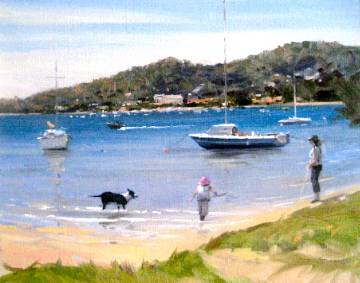Paul McDonald Smith Demonstration 15th February 2014
Landscape - Oils
Paul was a quiet but confident, experienced artist who has had forty years' experience as a professional painter. He has also accepted responsibility on committee work for major art societies, taught students and earned membership of the prestigious 20 Melbourne Painters. So he is no slouch! He is modest about his many successes. His early influence was Bill Dargie in the area of portrait painting, but lately he has turned to still life and landscape. He believes that a competent artist should be able to paint anything. I guess it is all about painting shapes, a matter of observation.

If you wanted to put a label on his style it is probably tonal
impressionism. He moves in the order of tone> form> colour. The order is
important. Many students go straight to colour, but, he says, that is the
last consideration. If you have a problem with a painting, question these
things in that order to find your solution.
He prefers to paint from life if possible. He cannot always get out into
nature, so still life gives him the opportunity to observe the real thing
and paint it.
He had a large hinged palette with the mounds of paint in a set order.
Always in that position so you can reach for a colour at speed when you
are on fire. A clutch of round brushes. When he washes them he ties the
points with thread so he can always get one with a point. Turps before
oil. He doesn't use any other medium. Quite a traditional approach and
well organised. You can see the value of years of experience.
To start today's picture, which would be a coastal seascape which he had
done before, he mixed some ultramarine and light red with turps to make a
thin mauve. He starts away from the sky, probably the opposite of a
watercolourist, and scrubs vigorously, getting the lights and darks in. He
mixes a few colours on the spaces in his palette. One brush per colour.
Gradually the picture begins to take shape. No careful following of drawn
lines yet.
He talks about painting against the form. This means not making the brush
strokes follow the shape of the object you are painting. Why not? It is
too early. Save that for a later stage. You can get fixated on a form when
you should keep an open mind. A lot of the work is just looking. Use a rag
to adjust what you don't agree with. Start that part again if you like.
Nothing is final in oil painting. Keep it all going at once rather than
finishing a part. It is never finished until it is all finished, so keep
it all fluid.
During afternoon tea he took a break, advising us to take advantage of a
break and come back with fresh eyes. There is no hurry. No time limits. Do
the easiest thing you can do at any given time. Don't try complex things
that you cannot do easily.
Lots of great advice from a professional. Thank you Paul McDonald Smith.
Colin Browne, WAA Secretary